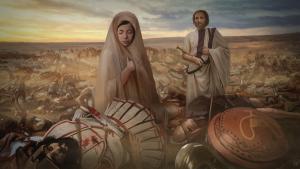On Tracy’s Fragments, Chapter 4, Christianity and Suffering

Suffering looms large in Tracy’s recent thought, so it’s disappointing that the chapter on “Christianity and Suffering” is the shortest in the book. This chapter also demonstrates a quality almost inevitable in a collection of essays written at different times in an author’s career. It repeats themes found elsewhere in the book without expanding on them much.
Central realities of suffering
Tracy lists five “central realities,” things we need to say about suffering (p. 83-84):
- No one can escape suffering in one’s own life and death and in the persons one cares about.
- Still, in the midst of pervasive, even intense, suffering, there are moments of great joy.
- Tracy identifies three ways people experience suffering. Some suffering is unavoidable in this life, including the anxiety of facing death. Some suffering we can, at least sometimes, choose, like the pain of childbirth or the much less intense pain of many creative endeavors. (Like wrestling thoughts into written words for me.) Finally some of us suffer as members of a suffering community. These communal experiences – plague, famine, persecution, colonization, slavery, genocide, purges – are mostly foreign to the rich and powerful. That lack would be the soul sickness of my own group, for whom a fundamental option for the poor is a necessary cure.
- There is no adequate philosophical or theological response to suffering. All theodicies, all attempts to justify God, “collapse in the face of radical suffering.” Instead of making sense out of suffering, Christians must “face attentively the reality of the cross of Jesus Christ.”
- Lastly, Tracy says, it is time to “rethink original sin.” Not all the suffering of this world is the result of sin, original or otherwise. There is plenty of suffering, even intense suffering, from natural causes (“not natural evils”).
The last two are the points I want to comment on.
Original sin, traditional interpretation
Since earliest Christianity, at least some scholars have recognized that the story of our first parents in the Garden of Eden is not straightforward history. That hasn’t excused theologians from the task of reconciling the essence of that story with scientific reality. The best traditional interpretation of that “original sin” that I know of goes like this:
- Whoever our first parents were, call them “Adam and Eve,” they belonged to a band of proto-humans descended from even earlier hominid species. Scientists say that to get the observed genetic diversity among humans today, you need an original pool of 2000 individuals or more, so there must have been more than one such band.
- These bands are on the verge of transitioning to truly human. They are developing symbols and language. At the right moment God instills a spiritual soul into one of the hominids. (It could have been two, a man and a woman, but not necessarily.) After a time the first sinful deed occurs, and this first sinner bequeaths to all his or her descendants a double legacy. We inherit both a spiritual soul and the negative consequences of that first sin.
- The Church teaches that all humans are descendants of that original sinner. Thus the human family is one. You might wonder, What about the couple thousand other proto-humans contemporary with that “Adam”? Wouldn’t some of us be descended from some of them? Perhaps all lines except those with spiritual souls died off. That’s what I think the writer who proposed this interpretation (in an article that I can’t locate), believed. But such a die-off is not necessary. After hundreds of thousands of years – in fact, long before that – lines of descent would have become so entangled that all of us would be directly descended from all of them. No lines needed to die out.
- Mythical and scientifically impossible features of the Bible story drop out. There is no Tree of Knowledge of Good and Evil or Tree of Life. God doesn’t walk in the garden in the cool of the evening. We are “humble clay” only in a metaphorical sense. More important, the “curses” of pain in childbirth and the sweat of one’s brow are nothing new. Pain and suffering didn’t first enter the world with that first sin. Life has always been a struggle for survival.
“Ancient sin”
Somewhere (not in this chapter) Tracy changes “original sin” to “ancient sin.” This retains the good in the previous account, namely that something evil happened. Not just pain but moral evil has invaded God’s good world. It also allows getting away from the idea of a single act by a single individual or pair. That relates better to the reality of the evil we experience. Evil is not just within individuals but looms above us in the form of communities, structures, and ideologies within which we live.
René Girard (see this post) tells a story of an ancient collective sin—scapegoating. Out of this common human sin come, first, hierarchical structures and, eventually, regular sacrifices. There’s a priesthood and a religion with myths that justify the system. In a later chapter Tracy refers to Girard’s work, not entirely positively. He thinks Girard’s “good insight” yields, as most insights tend to do, to “monomaniacal totalizing.” (p. 351)
One of the problems with reading David Tracy is that he has so much on his mind that one thought slips in while he’s pursuing another, and you wish he’d say more about the first. In this case I can’t tell what Tracy really thinks about Girard. For my part, I think what set humanity down the wrong path, with lasting effect, is more likely a communal injustice than private, individual sin.
The centrality of the cross
Tracy makes an interesting, surprising statement about the cross. The cross has not always been a central image for Christians. For the first four centuries of the Church, the image of the cross was not so common as it became later and still is. The cross “was not the shocking central symbol of [early] Christianity.” (p. 90) The symbols of Good Shepherd, Fish, and Eucharist were much more common. The cross was recognized then as a scandal, “as it should be recognized now.”
It seems that Christians have both gained and lost as time went by. We have gained an appreciation of the centrality of the cross but lost a sense of the cross as scandal. If I’m reading Tracy right, it’s a double scandal. First, as Tracy boldly puts it, God suffered. Tracy doesn’t qualify that suffering as “only” in the humanity of Jesus. He uses phrases like “God’s compassionate suffering in the cross of Jesus Christ.” This is the “loving God of Jesus Christ.” (p. 88) Even though Jesus is God, the God of Jesus is not exactly the same as Jesus. And that God suffers.
Again Tracy is too brief. The God of Jesus is the one Jesus called Father, and God the Father, as later trinitarian theology sees it, did not suffer on the cross. But compassion, which seems to imply a kind of suffering with another, surely is rightly said of the Father. But more needs to be said about what kind of suffering, if any, can be attributed appropriately to God.
Our only hope
The second part of the scandal of the cross is the fact that the cross is the main, and generally the only, thing Christians have to offer to a suffering world. We would like to find more optimistic things to say. Speaking to each other, of course, Christians can offer the hope of resurrection. That symbol says little to a world that either believes or doesn’t believe in its own form of existence after death. Or else it tells Christianity’s critics that Christians don’t care much about engagement in real life on earth.
People of any persuasion can appreciate the symbol of the cross, especially when Christians respond by following Jesus’ “way of the cross.” This many Christians have done throughout their history. Tracy says,
To pay attention to Christ’s cross as what gives Christians hope (not optimism) is to try to accept whatever pain, suffering, negativity life hands us by focusing on and participating in the divine and human compassion released by Christ’s cross, and to resist any injustice we observe, whether locally or globally. (p. 89-90)
Image credit: Crosswalk.com












